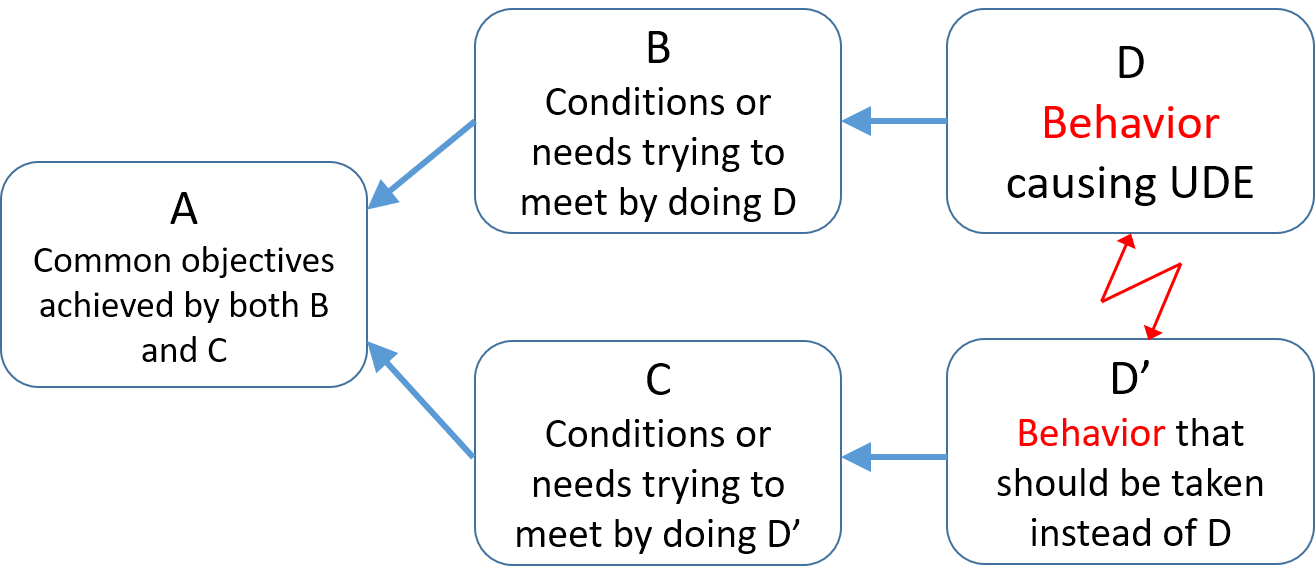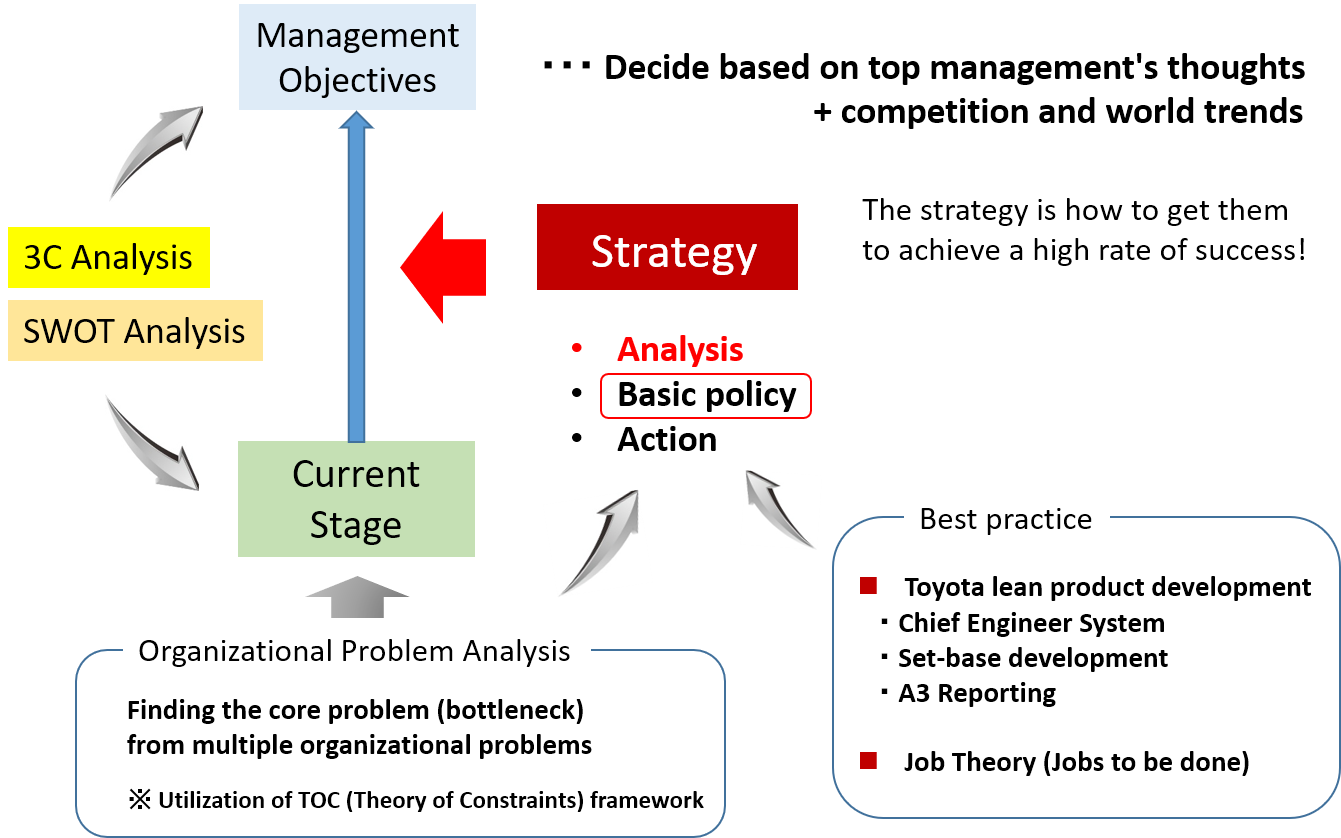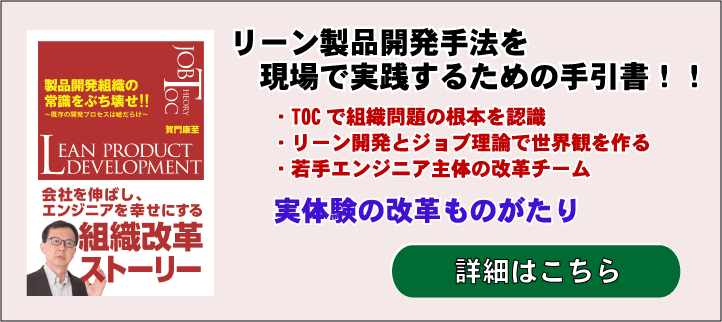

What should manufacturing companies do to survive and increase profitability in times of rapid change?
The Japanese product industry, which has dominated the world with its cheap, high-quality manufacturing, is now unable to differentiate itself with its production technology and is struggling amid rapid advances in IT technology and expanding market diversity. We would like to learn what each company must do now to become a company that continues to expand its earnings by leveraging its strengths to create new products and businesses that are globally competitive.
The ultimate goal of a company is to increase profitability. Based on our experience in implementing corporate reforms and product development innovations in the Japanese and U.S. manufacturing industries, we help manufacturing companies develop and implement strategies to improve their profitability.
While focusing on the throughput of the entire value chain – product planning, product development, procurement, production, sales, and service – we will show you how to develop strategies to create new products and businesses that will evolve your customers’ lives and become a company that your customers will appreciate.
Contents of this artic
Strategies for manufacturing companies begin with a narrowing of policy

There are many different approaches and ways of thinking about organizational reform in the manufacturing industry.
If you try to do it all as a policy, you will have to hold multiple values or have conflicting policies inherent in the company, which will complicate organizational management and, in some cases, lead to management collapse.
The difficulty in allowing different approaches and different ways of thinking to coexist can be described as a trade-off or dilemma.
The first step in developing a strategy is to deeply understand the tradeoffs and dilemmas in the matters and policies that the organization should aim for, and to clarify the goals to be achieved after recognizing the current status and DNA of the company.
Sorting Out the Dilemma of Reforming Manufacturing
The reason why we need to reform is because we want to be more profitable.
To increase revenue, we need to increase sales.
To increase sales, we need to make more products that sell.
Or, to increase sales, we need to acquire more customers or increase the sales price per unit.
If “products that sell” are “products that satisfy customer needs,” then here is the first option.
- Customer needs that are apparent
- Latent needs that customers are not even aware of yet
Naturally, you may hear some say that both are necessary, but an approach that directly listens to customers and leads to product improvements will yield results in a relatively short period of time, while for latent needs, there are many uncertainties and a trial-and-error approach is necessary, and above all, without the tools and know-how within the organization to discover latent needs, it cannot be done on a feeling alone.
Information obtained by directly listening to customers’ voices is actually easily available to competitors, so even if results are immediate, it may be difficult to differentiate oneself from others.
Thus, while there is such a dilemma even in the single point of creating a good product, when considering how to structure the product to continuously create good products, how to structure the organization to efficiently utilize human resources, and how to maintain core technologies and develop products, each of these options presents various choices that make it difficult to discard them.
When we consider our company’s situation from a MOT (Management of Technology) perspective, we believe that a manufacturing company can only be managed by “creating value,” that is, by purchasing components and turning them into products that are valuable to customers, and by “acquiring value,” that is, by having customers purchase products at high prices, thereby acquiring value as a company.
At this point, in order to “create value,” it is necessary to establish a value creation process, and in order to “acquire value,” it is necessary to create business value.
Options for Value Creation
- Remedial innovation (direct voice of the customer) and innovative innovation (technological innovation, latent needs
- Market-in and product-out
- Modular vs. integral architecture
- Platform strategy and individual optimization strategy
- Integrated product strength strategy and core technology deployment strategy
- Leader company strategy and follower strategy
- Emphasis on improving organizational capabilities and product development efficiency
etc.
Options for Capturing Value
- Vertical integration and horizontal division of labor
- make or buy (in-house or outsourced)
- Sell or not sell (core components sold externally or proprietary)
- Expansion in existing customer base and development of new customer base
- Sales volume (increase in number of customers) and profit margin (increase in customer value)
etc.
Recognize that the above options may be difficult to reconcile due to tradeoffs and dilemmas.
The strategy is about what to abandon and what to pursue.
What to choose should start with an objective evaluation of your company.
Objective analysis of your company’s current situation
The most important aspect of strategic planning is objective and correct analysis.
The first step is to objectively analyze the current status of your company.
The analysis should be conducted from a management perspective, and special attention should be paid to the following three items.
- Analysis of product characteristics
- Customer relationship analysis
- Analysis of organizational capacity
It is surprisingly difficult to evaluate oneself objectively.
An effective way to analyze objectively is to look at your company in comparison to other companies and successful companies.
The 3C analysis (company, competitors, and customers) and SWOT analysis are very effective tools, but I think objectivity is enhanced by using the various learnings from company research in your analysis.
For example, it is said that Toyota’s strength is its ability to continuously produce hit products based on its organizational capabilities and robust development process cultivated over a long period of time and supported by a top-notch project manager named Chief Engineer and the organizational functions and culture that support him.
Panasonic, a major general electronics manufacturer, has continued to follow a follower strategy, and has long been able to capture a high market share for many of its products on the strength of its brand power and customer relationships.
Fujifilm lost the foundation of its business of analog photography, but by expanding its core technology of film technology to other businesses, Fujifilm has developed fields such as cosmetics and pharmaceuticals and increased its profitability.
Examples of successful companies using core technologies include Ajinomoto’s amino acids, 3M’s adhesive technology, and Kyocera and Murata’s ceramic technology.
While it is important to analyze a company from the perspective of its top management to look at its major strategies, it is also important to evaluate the company internally, from the standpoint of its frontline and employees.
To find internal issues, we use TOC (Theory of Constraints) to identify one or two core issues that are at the root of various bad symptoms so that we can make a correct analysis of the current situation.
Reference article:
Structuring Problems in Development Organizations (Part I)
Lean Development, Job Theory and TOC Strategies for Organizational Change in Product Development
Focus on what you need to do and set goals
As the saying goes, “He who runs after two hares cannot catch them all.
We consider selection and concentration in order to continue to develop good products, to be accepted by customers, and to become a company with stable and growing earnings.
I will show you how to prioritize by example.
Prioritize the transformation from remedial product development to innovative innovation
- The company has a good relationship with its customers and has a system in place to get positive requests and feedback from customers via sales.
- Profitability has been maintained by developing improved products based on customer requests, but the company would like to achieve significant growth instead of remaining flat.
In such a situation, we can consider a reform to convert the customer’s direct voice into an idea that other companies are not aware of by processing it with a technical viewpoint.
A successful example of this is to establish an R&D marketing function within the development engineering department to collaborate with the sales and planning departments to create an organizational function that can convert direct voices into latent needs, thereby creating an advantage in product planning.
Prioritize building a system that can continuously produce hit products by solidifying organizational capabilities
This concept may be what most companies want to achieve.
The idea is that, with strong organizational capabilities passed down from generation to generation like Toyota’s, excellent human resources will be created one after another, and by continuing to produce strong leaders in the form of chief engineers, the company will be able to continuously produce good products that its competitors cannot follow.
While the concept is immediately understandable, this approach is very time-consuming.
It is necessary to reform with the strong desire and persistent support of the top management, along with the presence of a person who can serve as a model leader to take the lead.
We also recommend this approach, learning the essence of reform from Toyota and other successful cases, and creating and implementing a reform strategy that matches each company, rather than just imitating and adopting the form.
Our approach will be to build on small achievements one step at a time, while moving forward toward a long-range goal.
This approach often requires abandoning conventional wisdom and is likely to generate resistance within the company, but if accomplished, the results can be significant.
Reference article:
How to proceed with the Futureship Development Process Innovation and the required timeframe
Prioritize revenue growth by leveraging core technologies
Companies that sell materials, processing, and production technologies may also be suppliers of products to companies that make further end products.
In other words, they are providing parts, materials, and production technology to make the products of the delivery destination, but the technology may be utilized without understanding the principles of the final product or the value of the final product, i.e., it may not have any applications other than for existing customers.
It means that in some cases they do not know how their core technology increases the value of the end product.
The most effective way to increase revenue from core technology is to expand the use of core technology.
However, engineers of core technologies often do not have the skills to apply them.
They tend to manage their businesses in a wait-and-see manner, thinking that if they promote the excellence of their technology, they will receive inquiries from companies that manufacture applied products.
Some management may argue that it is not the company’s job to make products.
To reform this situation, a flagship strategy, in which the company expands sales of its core technology by creating and presenting its own applied products, is an effective approach.
However, we are starting from a situation where there is no in-house knowledge of the product.
In fact, I personally believe that this kind of research and creation is an ability that engineers originally possess, and I believe that it can be handled by drawing out individual abilities.
What we recommend is to analyze unknown products using a tool called a causal relationship map.
The causality map is essentially a tool for analyzing the trade-offs and unknowns of our products, but it can also be used as a tool for pursuing the principles of untapped products.
Reference article:
Referring to the examples above, set narrowly focused goals by considering your company’s current situation, strengths, and challenges from the top management and management perspectives, as well as from the front-line perspective.
Inventory and strengthen weapons for strategy execution

As the word “strategy” implies, a company’s revenue growth can be achieved by winning against the competition and overcoming changes in the marketplace as well as oneself.
And to fight, you need weapons.
In the process of formulating a strategy and creating an implementation plan, you will actually have to utilize a variety of tools and weapons, but the efficiency will differ depending on whether you can use the weapons that you originally have as a company organization or whether you acquire weapons while implementing the strategy.
I think it is important to routinely take stock of the tools and weapons that your company has to reform the company or make it as good as possible.
So what are the weapons to reform the company?
We believe that weapons are methods, frameworks, and rules that are useful for various improvements in day-to-day operations, such as productivity improvement, efficiency improvement, cost reduction, quality improvement, and increased probability of innovation.
Inventory of your company’s weapons
List any weapons that you can think of that your company may have in its arsenal right now.
- Past successes or success patterns
- Ongoing activities, even if they are still in the middle of the road
- Best practices and best practices of other companies shared within the company
We will look at each of these in a little more detail.
Past Successes and Success Patterns
For example, if the entire company has worked on TQC (integrated quality control method) in the past, and if there are any assets remaining, they can be utilized.
Although it will be quite difficult to expand the TQC concept to the entire company once again, including the thoughts of top management, it would be very effective to revive QC circle-like small-group improvement and proposal activities.
In addition, analytical tools such as the Seven QC Tools have been taken over by some people.
I think it is necessary to think of using up what is useful.
Not only TQC, but CS (Customer Satisfaction) activities were also used to revitalize companies.
If there is a successful case of a company’s original strategy, not only the strategy itself, but also the successful experience of how it was developed can be utilized.
Midway but ongoing activities
It is a good idea to focus on activities that are currently underway.
However, if an activity is currently not quite on track, we would like you to consider making necessary course corrections to improve the quality of the activity, taking into account what you have learned in the current situation analysis and goal-setting stages.
For example, this is an actual case study, but there was a company that was developing the 20% rule that Google is implementing in order to reform the way they work and promote innovation, i.e., 20% of working time should be spent doing what you like to do outside of your main job. According to the company’s self-analysis, the number of engineers who understood the overall structure and principles of operation of the company’s products was low. In one case, engineers not only improved their knowledge of the product, but also became more attached to it, increasing their motivation to work.
Best practices and best practices of other companies shared within the company
Learning from other companies is very important.
In this sense, as is often the case in business administration, it is common to use company research as a hint for one’s own strategies.
Toyota’s organizational capabilities and processes, as well as the environment in which excellent managers are nurtured, are truly something to learn from. We have also undertaken a number of organizational reforms modeled on the Toyota method of lean product development.
We have also learned a lot from the core technology strategies of Sharp and 3M, and the transformation of Fujifilm’s business model through the deployment of core technologies.
There are companies that have successfully developed fab spaces to return to the basics of manufacturing, and if you look around you to see if there are any examples of companies that have tried to apply such learnings to their own companies, you may find unexpected experiences within the company as well.
Routinely replenish your arsenal and strengthen your strategic capabilities
We want to replenish and strengthen the weapons and tools we have in our organizations to ensure the execution of our strategies, or to make the strategies themselves more powerful.
There are many different methods and tools, but all methods and tools are created with the goal of improving the company, so they actually contain many common ideas in their essence.
Even if there are slight differences in the way they approach and focus on the same goal, I believe that many of them are similar in their core aspects.
Furthermore, I believe that many of the methods and tools, in other words, the weapons used to execute strategies, cannot be effective if they are simply traced in the same manner.
In other words, if you try to adopt only the form, you will fail.
What is important is to absorb the essential significance of the methods and tools as an organization and put them into practice to steadily solve your company’s issues.
To this end, we recommend that you do not become overly committed to any one tool.
Ignorance is a sin. Learning many methods and ideas as an organization is not a waste of time.
Some of the methods and tools we particularly recommend are listed below as examples. If you haven’t learned them yet, start by learning them.
Looking at the 3C Analysis in the Context of the Time
The 3C analysis and SWOT analysis are very effective tools for strategy formulation, and I believe many companies have adopted them.
In our company, we use this 3C analysis with some modifications so that we can see the trends of the times.

When analyzing competitors and customers, we make predictions for the future by analyzing the flow from the past to the present.
For our own company, we decipher our company’s DNA from past and present performance, and determine where we want to go based on our DNA and future projections of competitors and customers.
If you are not familiar with 3C analysis and SWOT analysis, there is a risk of ending up with superficial analysis or becoming a skeleton.
This framework is designed to read the trends of the times and allows for a solid analysis of your company, competitors, and customers as trends.
TOC (Theory of Constraints) Problem Solving Framework
We use the TOC (Theory of Constraints) framework to analyze organizational issues in the field.
The TOC framework is a very large framework, but first of all, it is a very essential concept in that the root causes of bad symptoms occurring in an organization are actually converged in one or two core problems, and by finding the bottleneck and taking action there, throughput can be improved in the short term.
Using a tool called a conflict resolution diagram (cloud), the problem can be viewed objectively and accurately, eliminating organizational and individual assumptions.

Please refer to the separate article “Structuring Problems in Development Organizations (Part 1)” for an overview of this framework, if you like.
Toyota Style Lean Product Development
This is our preferred development method.
Toyota-style lean product development, which is now widely used around the world, was actually systematized by American academics (Allen Ward, et al.) as a mixture of their own theory and the results of their actual visits to Toyota.
Broadly speaking, it consists of three key elements.
- Chief Engineer System
- Set-Based Development
- A3 Report
Of these, the Chief Engineer and the A3 Report are actually practiced at Toyota and have been introduced in various books.
Set-based development is a very interesting concept, and the essence of this concept is certainly in Toyota, but it is not used under the name set-based.
In this area, we believe that the idea proposed by Allen Ward was named set-based, and that Toyota actually had a similar idea.
In any case, it is true that we can learn a lot from the lean product development method originated by Allen Ward.
However, since it is only a theoretical method, each company needs to proceed in accordance with its own actual situation in order to put it into practice.
The historical background of the Lean product development method, its differences from general methods, and key points for putting it into practice are explained in a separate article, “What is Toyota-style Lean Product Development?“.
Project Management Methodology
Toyota’s chief engineer system is perhaps the most evolved form of project manager.
Beyond being a mere leader of a development project, the chief engineer is a superman who manages the entire value chain from planning, design, production, purchasing, sales, and service, all by himself, and even has P&L responsibility for the target product.
The fact that the development process itself is entrusted to a single charismatic leader is something that many other manufacturers cannot imitate, but perhaps Toyota’s real strength lies in its organizational capabilities and the soil that continuously produces such supermen.
Even if they are not super project managers to this extent, I think it is a major management issue for many companies to develop excellent project managers.
There is an organization headquartered in the U.S. called the Project Management Institute (PMI) that is dedicated to the development of project managers.
This PMI regularly publishes the PMBOK (Project Management Body of Knowledge : read as “Pin Bok”), which systematizes knowledge on project management, with the aim of raising the level of project management in companies.
Some companies use the PMBOK as a training material for project managers and have them take the PMP exam, a certification exam for project managers sponsored by PMI, to become qualified.
Personally, I believe that the PMBOK only provides knowledge, and considering that what is important in project management is practical skills, it is necessary to develop knowledge + practice.
However, I think that it is better to have them acquire at least an outline of knowledge than to have a method of appointing the most qualified person from the development engineers without any knowledge and without giving them any weapons.
Reference article:
Marketing Theory
We recommend the “Job Theory” method proposed by Professor Christensen and others at Harvard Business School.
It is a new marketing tool based on the idea that “customers do not buy products for the products themselves, but adopt them to get their Jobs to be done.
However, since Christensen’s book does not provide a framework for this method and only shows the concept with examples, it may be a difficult method to put into practice.
At our company, we propose our own framework by combining this method with story thinking, design thinking, etc.
For details, please refer to another article, “Teaching a Framework for Putting Job Theory into Practice“.
Marketing is not just a tool to sell products.
It is more about growing the company itself and governing the practice of corporate strategy itself.
Philip Kotler, the god of marketing, describes the evolution of marketing in terms of 1.0, 2.0, 3.0, and 4.0.
I think it is not so much that marketing itself is evolving, but rather that the market is changing so quickly that we are evolving our theories to keep up with the changes.
The current marketing mainstream in many symbols is called STP marketing, but this is only the 2.0 stage in Kotler’s evolution.
Many Japanese companies may be behind the times in their marketing perspective.
Here is a brief article on how to learn marketing. Please refer to it.
Reference article:
Here are some books to help you learn marketing in an easy-to-understand way
How to properly understand and implement the strategy

Once we have narrowed down our goals by selecting what we should do and what we should not do to increase our earnings as a manufacturing company, and have enhanced our arsenal for strategy execution, the last step is to understand the correct strategy and then formulate and implement the strategy.
Right Strategy and Wrong Strategy
As mentioned in another article, “Three Key Elements of Strategy Planning for Development Organizations” the essence of strategy is to bridge the gap between lofty goals and the current situation to increase the probability of achieving those goals.
The basic structure of a strategy is
- Diagnosis and analysis
- Basic Policy
- Actions
If it is not accompanied by action, it cannot be called a strategy.
Here are some examples of wrong strategies.
- Mistaking setting high goals as a strategy
- Empty ones that do not address key issues
- Listing all the issues and trying to address them all
A good strategy is surprising and simple. It is also something that no one would have thought of, but that makes sense when you hear about it later.
Reference: Seminar on Strengthening Strategic Planning Skills
Development Strategy 7 Steps

The diagram above shows the overall picture of our recommended strategic planning.
Management objectives should be narrowed down as discussed in the introduction, but should be adjusted as necessary according to the results of the 3C analysis and SWOT analysis.
In addition to the analysis from the management perspective, the current situation analysis identifies core issues from the field perspective using TOC (Theory of Constraints).
After the analysis, we will utilize our company’s arsenal in determining basic policies.
We especially recommend incorporating the best parts of the Toyota method of lean product development and the new marketing method, Job Theory, as best practices.
The seven steps of the development strategy are summarized below.
Seven Steps to Profit Improvement Strategies for Manufacturing Companies
- Early initiation of activities to develop essential thinking and thinking skills in individuals and organizations
(e.g., A3 reporting culture, use of cause-and-effect maps) - Deeply understand best practices and incorporate them into your company’s arsenal
(Lean product development, job theory, etc.) - Objectively analyze the company, competitors, and world trends (3C, SWOT analysis)
- Identify core organizational issues (bottlenecks) (ex., use of TOC)
- Set goals based on top management’s thoughts and analysis results
- Utilizing the company’s own weapons, determine a basic strategic direction based on the analysis results and responses to core issues, and formulate an action plan, taking into account obstacles and side effects
- Continuous improvement through the PDCA cycle, periodically returning to 3
Strategy does not commit to results.
It is a ploy to increase the probability of winning.
Sometimes it is important to be bold and not lose, and withdrawing or changing course is a necessary action in the strategy.
The higher the goal set, the longer the road to reach the goal can be.
It is also very important in strategy execution to maintain high goals over a long period of time, while making sure that the action plan reaps results in small steps over a short period of time.
We support manufacturing companies in developing and implementing a strategy that will not lose.


